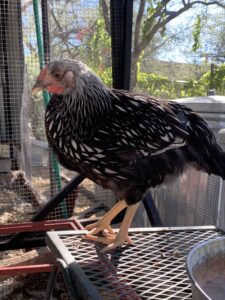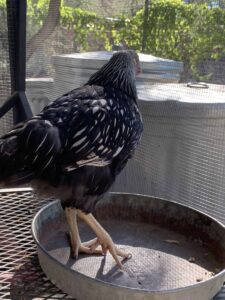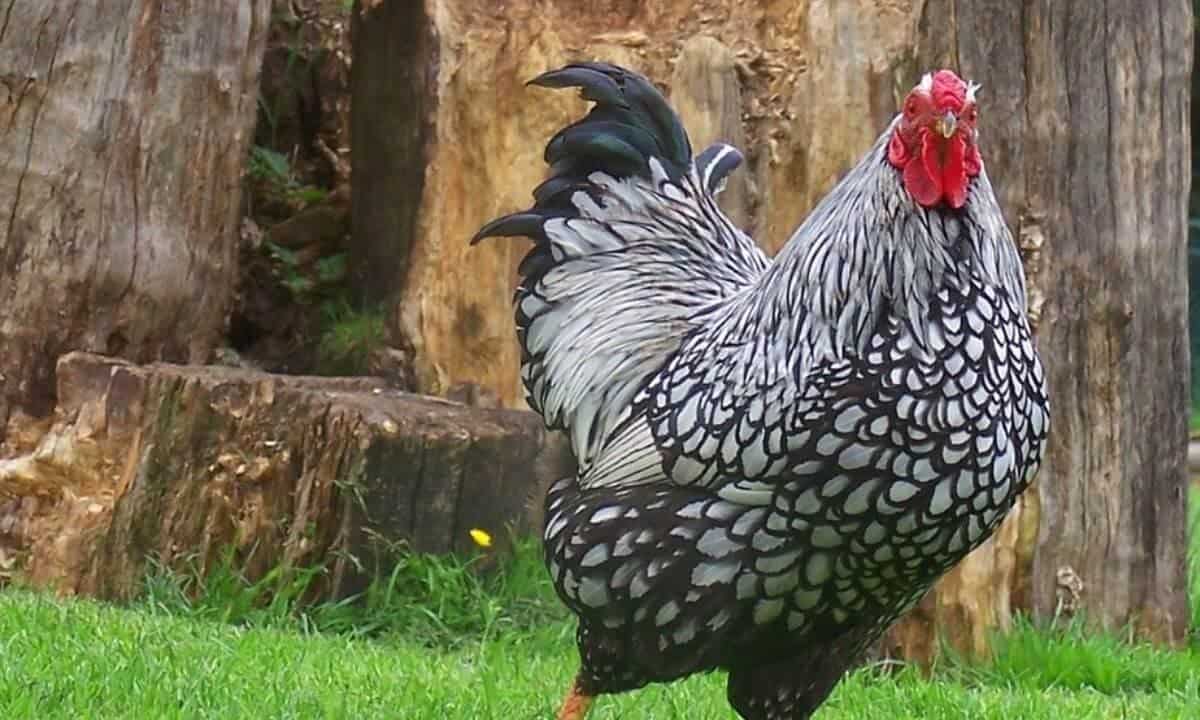Silver Laced Wyandottes have been around since the 1800s. They were bred in the US to lay consistently throughout the year. Today, they’re excellent chickens for both egg-laying and their desirable meat that bares yellowish skin.
It’s a common breed that’s considered versatile thanks to their ability to live in cooler climates, while withstanding warmth too. They’re highly sought after by chicken farmers and backyard hobbyists.
The Silver Laced Wyandottes are the origin of the varied Wyandotte line. They lay about 200 eggs annually and are large, feathery, docile birds. They’re excellent for families, and urban living.
Silver Laced Wyandotte History
Silver-Laced Wyandotte chickens are named after the Wyandotte Nation, a Native American tribe. The origins of the name come from the tribe’s assistance to settlers in the land.
Like much of history, the breed’s exact origins can’t be determined—though the current theory is that Hamburgs and Brahmas were used to create the Wyandotte line.
The Hamburgs are silver spangled and have attractive combs. The Brahma’s dark and interesting patterns were also a desirable feature.
We know a little more about who created this breed: H.M. Doubleday, John Ray, L. Whittaker, and Fred Houdlette. They bred the chickens in 1870s New York. The men needed a chicken that could lay throughout the year in a consistent manner — sourcing food was vital for the settlers.
And so, this charming, silver breed sprang into being, and was soon included in the American Standard of Perfection recognizing it as an official breed of poultry in the country.
Hardiness
As the bird was bred to withstand all climates throughout the year, it thrives in cold weather. They’re extremely feathered, so they can handle chilly winds and air. Overall, they are hardy to most temperatures. Silver Laced and other forms of Wyandotte are generally regarded as hardy because of their thick plumage.
They have small combs and wattles amidst fluffy feathers that keep them insulted and protect them from frostbite. Take care to keep them dry in cold winter months.
Despite their feathery bulk, the birds can also live in warmer climates, but they need to be kept cool thanks to their physique.
Appropriate shelter is necessary to keep them warm and dry and sheltered from storms. Owners should ensure they create adequate shelter for them to seek shade in. It will also need to protect them from predators. They should also have access to clean, cold water throughout the day.

Appearance
The first thing you’re likely to notice is their beauty. Their striking feathers are silver and white and laced with black. Their tail feathers are mostly black. They possess a rotund physique, although their legs are farther apart than your average chicken. These legs are long and bald, which makes them stand out.
On the opposite end, you’ll find their rose comb is low and flat in appearance, and doesn’t protrude much from their heads. Silver Laced Wyandotte chicken will generally molt in late fall as it gets colder.
Finally, despite the “silver laced” in their name, that’s not the only variant of the Wyandotte chicken that exists. There are 17 colors we know of, including gold, buff, blue and lavender laced versions of the bird to name a few. See how the Silver Laced chicken compares to the Golden Laced Wyandotte and the Blue Laced Red Wyandotte.
Silver Laced Wyandotte Size and Weight
With thick, beautiful feathers, they appear bulky and heavier than they are. They are considered to be medium-sized chickens. They’re quite hefty for chickens, making them wonderfully tough birds.
Much of this bulk comes from their dense feathers. The average size of a Silver Laced Wyandotte is 6 pounds for a female, 8 pounds for males.

Personality
After covering what’s on the outside, we’ll dive within. First of all, the Silver-Laced Wyandottes are friendly, docile fowl that are eager to help their human friends.
They bond easily, to adults and children alike. If you want pet chickens that won’t mind the curious, petting hands of a toddler, then this is the one to choose. They’re gentle, and unlikely to attack an inquisitive, friendly touch. They’re loyal birds who’ll follow their owners around.
Silver Laced Wyandottes get along with other livestock, making them an excellent choice for a varied barnyard. If keeping them among a mixed breed flock, they tend to keep with their own breed.
They will be toward the top of the pecking order.
It’s important to know they are far from humble. They show off to other chickens mercilessly, displaying their grand feathers. They’re not a great choice if you want a mixed selection in your coop; the integration may not go as smoothly as you’d like.
They will need enough space in the coop and areas to explore. Overall they do well in confined areas.
Broodiness
Silver-Laced hens are reliable sitters and have a tendency to go broody. They make excellent mothers. To offset their broodiness, it’s important to gather eggs daily.
Noise Level
Although they’re quite proud, they don’t make a fuss about it. They’re pretty quiet birds and won’t wake you up in the morning. Silver Laced roosters perform their morning duties well, but they won’t keep up their call during the day.
The hens may get a little chatty, but only during egg announcements. As they’re reliable layers, you can learn when to expect these announcements and form your quiet time around them.
Egg Production
Silver Laced Wyandottes are a dual purpose breed. They have a laying age of about 18 weeks old, but some pullets may take longer according to owners. These birds can produce up to 200 eggs a year. However, if you keep them in great conditions and treat them well, this could increase to approximately 240. On average, they lay about 4 eggs per week, making them a popular chicken breed for raising as a backyard flock.
Best Laying Conditions
These laying conditions pertain to any hen, but ensure that you put them into practice with your Silver Laced Wyandottes:
- Nutritious feed
- Clean water
- Clean feathers
- Secure housing with enough space in the coop
- Spacious yard or chicken run
- Natural lighting
- Protection from weather
The better the components above, the more eggs the birds are likely to lay as they will have room. Being confined and stressed generally lowers egg production.

Silver Laced Wyandotte Roosters vs Hens
Most people obtain Silver Laced Wyandottes for their eggs, but if you’re interested in breeding, waking up at the crack of dawn or rounding out your coop, you may want a rooster.
So how do you tell if a Silver Laced Wyandotte is a rooster? Pretty much the same way you’d discern any rooster and hen. Here are the key characteristics:
- Larger, redder wattles and combs
- Slower feather growth
- Wide appearance — roosters are more robust
- Large feet on lanky legs
- More shine than hens following their first juvenile molt
There won’t be behavioral differences with the roosters until they’re around 5 months old, which is crowing age.
Sexing Silver Laced Wyandottes
However, if you don’t have time to wait for the crow or to notice the characteristics above, don’t worry. A poultry expert will generally be able to tell you your bird’s sex from pictures at about 8 weeks old.
Sexing chickens such as Silver-Laced Wyandottes is a bit more challenging than other chicken breeds.
How to Care for Silver Laced Wyandotte
Despite their apparent hardiness, these birds are subject to the same ailments as any other chicken. In some areas they’re more at risk due to their builds, so be sure to take excellent care of your noble birds.
Feather Care – Dirt
Keeping your Wyandottes clean and healthy is vital. As they’re so densely feathered, it’s easy for them to hold onto dirt and mites. The dirt can deter breeding in two ways. It can repulse the rooster, like with any species, or it can make the feathers clump together creating an access issue.
Take extra care when cleaning your Wyandotte’s feathers regardless of your intent with the birds, but be extra cautious if you plan to breed them. Also be sure to keep their yard and coop clean of dirt, debris and their own excretions so there’s nothing to get caught up in their feathers.
Feather Care – Mites
Mites are another reason to keep your chicken’s feathers smooth and sleek. Chicken mites are exactly what they sound like: invasive bugs that can nest in the feathers and attack the skin. They cause pain and irritation, which can stress out the chickens resulting in lower egg production.
Heat Exhaustion
While the Wyandottes can live in warmer climates, it doesn’t mean it’s what’s best for them. If you’re in the southwestern United States in a desert climate or somewhere equally scorching, consider a breed with fewer feathers.
That said, you can make warmer environments more Wyandotte-friendly. Ensure they have access to cold water both in and outside of their coop, and that there’s plenty of shade in the coop for them to get a break from the beating sun.
Learn how to keep chickens cool in the summer heat. If you can’t create this environment for them, or you’re in one of the hotter areas, this isn’t the bird for you. Consider the Orpington instead.
Special Needs
As Wyandottes are bulky birds, they need a decently-sized spot each. They’re also proud and far from humble so each bird in the coop will need its own personal space. Two square feet per bird should be the minimum area you provide them within the coop.
Wyandottes are also social creatures who like their freedom, so ensure their yard is at least as big as their coop if not bigger. They should have free access to this space day and night, to ensure they can follow their own stress-free schedule.

Frequently Asked Questions
Are Silver Laced Wyandottes Beginner Friendly?
These birds are beginner friendly. Their gentle temperament makes them perfect for someone who’s not used to dealing with more aggressive or skittish birds.
Plus, being quiet birds, they won’t upset your neighbors. This makes them ideal for backyards as well as close living such as in urban areas.
Your biggest challenge as a beginner will be keeping them comfortable and healthy, but you won’t face direct difficulties from the breed of bird itself.
Are Silver Laced Wyandottes Aggressive?
They’re far from aggressive. They may be competitive with other chickens, but other bird species, animals and humans are equals to them. These birds are a fantastic breed to have around kids, over-curious but friendly dogs, and in busy urban areas where the public will be able to crane their necks and gawk at the wandering birds.
What’s the Silver-Laced Wyandotte’s Average Lifespan?
Silver Laced Wyandottes generally live 6–12 years, like most chicken breeds.
Are They Good Layers?
They are considered to be good layers.
Do Silver Laced Wyandottes Lay in Winter?
Yes, they do lay in winter. People bred them to be versatile and lay year-round.
The chickens will lay better under optimal conditions, including having enough space and enough light. Supplement with artificial lighting if they don’t have access to sunlight. The end result is that they lay four eggs per week for the entire year—most of the time.
Please note, not all hens will continue laying throughout the winter. They’re typically unbothered by cold, but if it gets a little too chilly for them they may stop laying for a while. It depends on the hen and her individual sensitivities. It can also depend on how bitter the climate is.
What’s the Broodiness of Silver Laced Wyandottes?
Silver Laced Wyandottes are broody birds who protect their young. They’re excellent breeders and will raise their chicks very well. However, if you’re not interested in chicks, then you may want to look for a less broody breed. Otherwise, be sure to collect their eggs daily.
Are Silver Laced Wyandottes Right for You?
Silver Laced Wyandottes are beautiful, bulky, robust birds that lay year-round and make excellent companions too. They may not be the best hens to have in a mixed coop, but if you’re breed-loyal, this is an excellent one to pick.
They are friendly and make for a good pet. People raise them because they are a dual purpose breed, producing eggs and meat. Silver-Laced Wyandottes are good layers. They are also reliable layers throughout the year.

